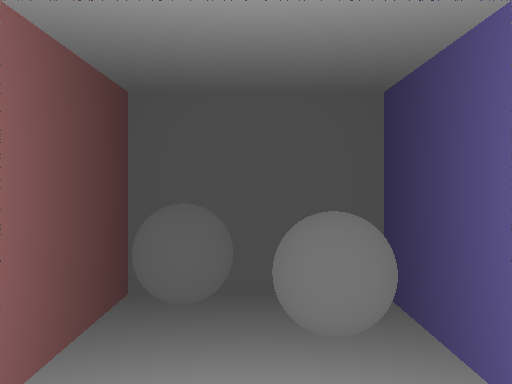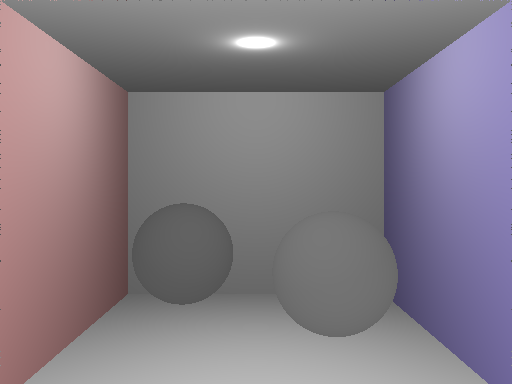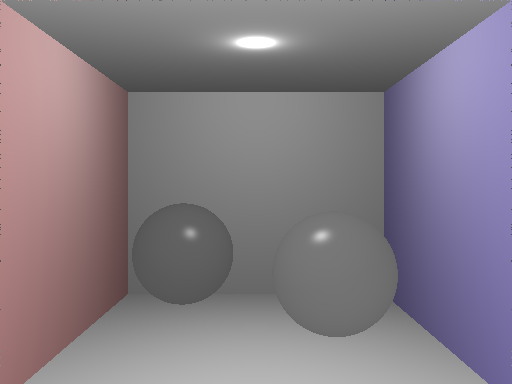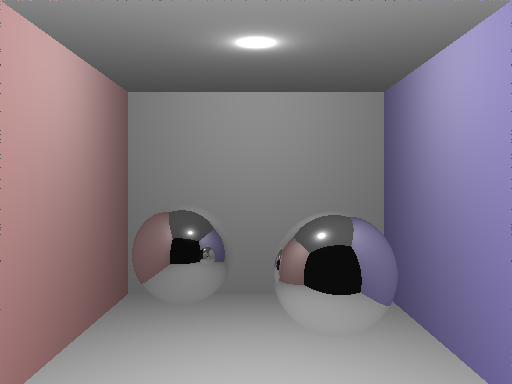ray_trace function.
A suggested progression can be as follows.
- add diffuse reflection to the distance-attenuated image
produced by the previous assignment:
- if the
diffusematerial component is not zero, iterate through the list of lights in the scene - for each light, find the direction vector from the
hit point to the light (L - hit where L
is the light position and hit is the hit
point set by the
find_closestfunction) - compute N · L (where N is the normal
at the hit point that is also set by the
find_closestfunction) - if N · L is greater than
0and less than1, compute Id which is the light color scaled by N · L divided by the distance to the light r, i.e., (N · L)/r - add in the diffuse material color multiplied by Id
- clamp the resultant color to the range [0,1]
(meaning that if any of the R,G,B components are
less than 0 set them to 0 or if
they are greater than 1 set them to 1
— write a convenience method
clamp: lo: hifor thepixel_ttype)

- if the
- add in processing of lights and specular reflection:
- if the
specularmaterial component is not zero, compute the reflective color obtained a recursive call toray_tracefollowed by adding in specular highlights (see below; in this step just put in a placeholder for the recursive call and add in the specular highlights first) - clamp the resultant color to the range [0,1]

- if the
- next, add in specular highlights:
- if the
specularmaterial component is not zero, iterate through the list of lights in the scene - for each light, find the direction vector from the
hit point to the light (L - hit where L
is the light position and hit is the hit
point set by the
find_closestfunction) - compute N · L (where N is the normal
at the hit point that is also set by the
find_closestfunction) - if N · L is greater than
0and less than1, compute Is which is the light color scaled by (R · V)n divided by the distance to the light r, i.e., (R · V)n/r - add in the specular material color multiplied by Is
- clamp the resultant color to the range [0,1]

- if the
- finally, add in the recursive call to
ray_traceto produce the final image:- allocate a new
pixel_t *refcolorpixel vector which will hold the color returned by theray_tracecall - compute
outthe reflection direction vector, 2 (N · -dir) N - -dir (don't forget to normalize) - call
ray_tracewithhitandoutacting acting as the ray position and direction, along withraydistbeing passed-by-value (this is used to cull the ray if the ray distance is too large, e.g., 100) - blend the current
colorandrefcolorby multiplyingcolorbydiffuseandrefcolorbyspecularand adding

- allocate a new
cbox.txt
camera cam
{
pixeldim 512 384
worlddim 5.12 3.84
viewpoint 2.56 2 5
}
light top
{
location 2.56 3.80 -1.5
emissivity 1 1 1
}
material gray
{
ambient 3 3 3
diffuse .9 .9 .9
}
material green
{
ambient 0 5 0
diffuse 0 .5 0
}
material salamander
{
ambient 3 2 2
diffuse .9 .9 .9
}
material slate
{
ambient 2 1.8 3
diffuse .9 .9 .9
}
material transparent
{
ambient 3 3 3
diffuse .1 .1 .1
specular .9 .9 .9
alpha .9
ior 1.83
}
material chrome
{
ambient 3 3 3
diffuse .1 .1 .1
specular .9 .9 .9
}
plane backwall
{
material gray
normal 0 0 1
point 0 0 -5
}
plane leftwall
{
material salamander
normal 1 0 0
point 0 0 0
}
plane rightwall
{
material slate
normal -1 0 0
point 5.12 0 0
}
plane ceiling
{
material gray
normal 0 -1 0
point 0 3.84 0
}
plane floor
{
material gray
normal 0 1 0
point 0 -0.2 0
}
sphere left
{
material chrome
center 1.25 .75 -4
radius .9
}
sphere right
{
material transparent
center 3.7 .7 -2.3
radius .9
}